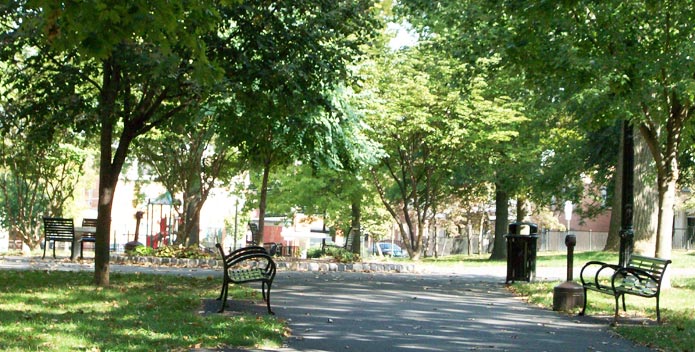Just what is green infrastructure?
Rain falling onto a forest, meadow, or wetland soaks into the ground and slowly filters into nearby rivers and streams. But when that land is developed and turned into a city full of buildings, streets, and parking lots, hard surfaces replace the natural filter—leaving water with nowhere to go.
Most cities today were built to solve this problem by engineering concrete drainage ditches, stormwater drains, and sewers that rapidly funnel the water—and the harmful pollution it picks up—directly into rivers and streams.
Green infrastructure rethinks this model and seeks to mimic the function of the forests and fields cities replaced. The idea is to capture and clean the rain where it falls, slowing the flow of water so it can filter into the ground and reducing the amount of pollution that ends up in local waterways and the Bay.
Green Infrastructure Practices
Green infrastructure comes in many forms. Unlike traditional stormwater systems that rely on a centralized network of sewers, green infrastructure can be spread throughout a city's landscape and incorporate practices both big and small.
Some green infrastructure is designed to capture rainfall at a single home or building, such as:
- Rain Barrels The rain that falls onto a home's roof is typically routed through gutters and downspouts into a city's stormwater sewer system. Rain barrels collect water from the downspout and store it, where it can be used to water plants and lawns. Downspouts can also be directed to drain into landscaped areas where water can soak into the ground.
- Green Roofs Some buildings capture rainfall by planting vegetation directly on top of their roofs. The plants' leaves slow down the rain as it falls, and water is captured in the soil. Green roofs can provide a way for cities to reduce hard surfaces in dense urban areas, such as city blocks with high-rise offices and apartment buildings.
Other types of green infrastructure are incorporated throughout city streets and neighborhoods, including:
- Permeable Pavement Certain types of concrete and asphalt, known as pervious or porous, are designed to let water trickle through to the ground below. Creating streets, sidewalks, and parking lots with these materials reduces the amount of water flowing off hard city surfaces into stormwater drains when it rains.
- Rain Gardens City streets and neighborhoods can be designed to direct water into low areas planted with vegetation. These rain gardens collect water flowing off the surrounding streets and driveways, allowing it to absorb into the soil and plants.
- Bioswales Much like rain gardens, bioswales are ditches planted with vegetation. They are often used to line streets or parking lots to collect water and move it slowly to areas where it can soak into the ground.
- Urban Tree Canopies Similar to green roofs, increasing the tree canopy within cities and neighborhoods slows the fall of precipitation and improves the ability of the soil to capture water, which in turn slows down stormwater. Trees also provide shade, which reduces the intense heat of developed areas, also known as the "urban heat island effect." The cooling of neighborhoods is good for everyone, and even helps save in energy costs in the summer.
- Streamside Forests Streamside trees and shrubs prevent pollution from entering waterways, stabilize stream banks, help reduce flooding, provide habitat for fish and other critters, and keep streams cool during hot weather. They even help the stream cleanse itself of pollution.
Benefits of Green Infrastructure
Green infrastructure is primarily used to help cities manage stormwater. However, green infrastructure practices can provide many additional benefits for communities, including:
- Contribute to healthier communities by improving air quality, providing green space for recreation, and reducing the higher air temperatures caused by urban and suburban development.
- Help keep buildings cool, reduce energy costs, and increase the value of office buildings and apartments.
- Reduce localized street flooding and the strain on water infrastructure.
- Make neighborhoods more visually attractive.
In the end, more green infrastructure means less pollution flowing into rivers, streams, and the Bay!
Additional Ideas and Information
Learn more about the benefits of green infrastructure on our web page Solutions: Community Projects.
See our case study of Lancaster, Pa's urban greening initiative and our urban tree canopy initiative in Hopewell, Va.
The EPA's Green Infrastructure website includes more types of green infrastructure, examples, resources, webcasts, case studies, partnership opportunities, and a listserv featuring updates on publications, training, and funding opportunities.
The University of Maryland Environment Finance Center's report, Holistically Analyzing the Benefits of Green Infrastructure: Guidance for Local Governments provides information about the direct benefits and co-benefits of green infrastructure for water and air quality, habitat, wildlife, people, and communities.
See our Stormwater Management Resources page for more reports, fact sheets, and helpful websites.
Learn more about the incredible and diverse benefits of trees and opportunities to participate in the Keystone 10 Million Trees Partnership.



